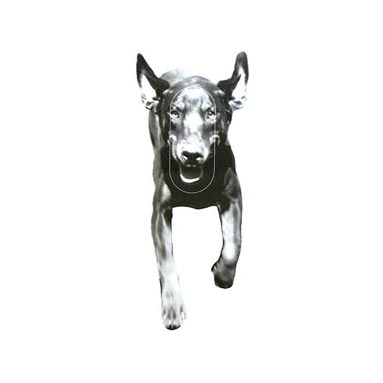dogs
Beyond that road lies a shining world. Beyond that road lies despair.

Why do dogs tilt their heads when we talk to them?
Biologist here. Head tilting allows an animal to gain information about the vertical placement of the sound (how far up/down it is, relative to the axis of the skull). It is assumed that canids do head-tilting to try to localize a sound better. This is backed up by the fact that canids do a lot of head-tilting when hunting small prey that are hidden behind grass or snow. Generally — as bilaterally symmetrical animals, mammals already get pretty good information on left-right placement of a sound, due to the fact that we have an ear on the left and a different ear on the right — that means we can get left/right info by things like, time of arrival of the sound at each ear, and loudness of the sound in each ear. But up/down information (how high or low the sound source is) for a sound that is coming from directly in front can be difficult to figure out. This is a challenge for a predator that is typically approaching prey that are right in front. The head tilt solves this problem by offsetting the two ears vertically so that sounds from lower down will hit the lower ear first, and will also be ever so slightly louder in the lower ear, and vice versa for sounds coming from higher up. […]
With domestic dogs looking at a human, typically they already know the sound is coming from the human; they seem to just instinctively add the head tilt when hearing a puzzling sound, even if they’re pretty sure where it’s coming from.
‘When I don’t have red, I use blue.’ –Picasso
Ivan Pavlov is best known as a founding figure of behaviorism who trained dogs to salivate at the sound of a bell. […] Pavlov didn’t use a bell, and for his real scientific purposes, couldn’t. English-speakers think he did because of a mistranslation of the Russian word for zvonok (buzzer). […]
Although one would expect that this investigator of reflexive reactions would think otherwise, he believed in free will. […]
He didn’t win his Nobel Prize (1904) for research on conditional reflexes, but rather for his studies of digestive physiology.
{ Oxford University Press | Continue reading | More: New Yorker }
Better where she is down there: away. Occupy her. Wanted a dog to pass the time. Might take a trip down there.
Journalists consider the importance of events and the audience’s interest in them when deciding on which events to report. Events most likely to be reported are those that are both important and can capture the audience’s interest. In turn, the public is most likely to become aware of important news when some aspect of the story piques their interest.
We suggest an efficacious means of drawing public attention to important news stories: dogs. Examining the national news agenda of 10 regional newspapers relative to that of the New York Times, we evaluated the effect of having a dog in a news event on the likelihood that the event is reported in regional newspapers.
The “dog effect” is approximately equivalent to the effect of whether a story warrants front- or back-page national news coverage in the New York Times. Thus, we conclude that dogs are an important factor in news decisions.
Oh, sorry. I didn’t realize we were using your personal, specific definitions for so many words.
This study is related to the use of natural ventilation silencers for the howling and barking (hereafter referred to as “barking”) of dogs. With the spread of nuclear families, low birth rates, and aging populations, pets play an important role in advanced nations. In Japan, the number of complaints and problems caused by the noise created by barking dogs is increasing; it represents the major component of noises in living spaces, thus necessitating some sort of countermeasure. In addition, dogs in veterinary hospitals are housed in connecting cages; one dog’s barking can cause others to bark as well, creating stress in the other animals in the hospital.
One method being considered to remedy this situation is the attachment of a sound insulating board to the opening of the cages and the utilization of forced ventilation. However, the use of sound boards and forced ventilation creates a number of issues, including problems such as hindrance in communicating with animals, noise associated with ventilation intake and output, noise from fans within cages, cost, energy consumption, and the risks of malfunction and power outages; collectively, these problems make this solution unfeasible. […]
We created a prototype based on resonance within a rectangular chamber divided into cells, adding nonwoven sheets to the interior, tail pipes, and coaxial side branch tube silencers to the open end. We then assessed the sound attenuation performance.
{ International Journal of Mechanical Engineering and Applications | PDF }
Knutzen dissuaded Kant from the theory of pre-established harmony, which he regarded as “the pillow for the lazy mind”
This article examines the reasons for the Chihuahua breed’s popularity in contemporary western society by looking at two sets of data: Chihuahua handbooks and The Simple Life show, starring Paris Hilton and her Chihuahua Tinkerbell. The article argues that the Chihuahua is a holy anomaly. […]
The Chihuahua – or the bonsai wolf – transcends two binary oppositions fundamental to contemporary westerners: subject/object and nature/culture.
{ SAGE }
Charles Darwin, in his book The Expression of the Emotions in Man and Animals, mentioned that baboons yawn to threaten their enemies, possibly by displaying large canine teeth

{ 1. Terry Magson | 2 }
All the best sands of my life are somehow getting into the wrong end of the hourglass
Ask most people how to determine a dog’s age in human years, and they’ll probably say, “Multiply by seven.” However, this method is inaccurate, and more so the older a dog gets. […]
Dogs mature faster than humans, reaching the equivalent of twenty-one years in only two, but then aging slows to an average of four human years every year after.
So, next time someone asks you a dog’s age in human years, you’ll know how to give a more accurate answer. Subtract two from the age, multiply that by four and add twenty-one.
The bulldog of Aquin, with whom no word shall be impossible
{ Driving school for dogs in New Zealand | Thanks Tim }
British romantic poet Lord Byron sent female admirers dog hair in place of his own
A new study shows how the behavior of dogs has been misunderstood for generations: in fact using misplaced ideas about dog behavior and training is likely to cause rather than cure unwanted behavior. […]
Contrary to popular belief, aggressive dogs are NOT trying to assert their dominance over their canine or human “pack.” […]
The researchers spent six months studying dogs freely interacting at a Dogs Trust rehoming centre, and reanalyzing data from studies of feral dogs, before concluding that individual relationships between dogs are learnt through experience rather than motivated by a desire to assert “dominance.”
Not yet. At four he. All said four.

Seventy-four percent of dog owners believe that their dogs experience guilt. […]
There is plenty of evidence for what scientists refer to as primary emotions – happiness and fear, for example – in animals. But empirical evidence for secondary emotions like jealousy, pride, and guilt, is extremely rare in the animal cognition literature. The argument usually given for this lack of evidence is that such secondary emotions seem to require a level of cognitive sophistication, particularly when it comes to self-awareness or self-consciousness, that may not exist in non-human animals.
painting { Pan Deng }
You think you balling because you got a block, he think he balling because he got a block

{ Maddie the Coonhound | Thanks Glenn }
There’s only love, and there ain’t no replacement

Human interactions often provide people with considerable social support, but can pets also fulfill one’s social needs? Although there is correlational evidence that pets may help individuals facing significant life stressors, little is known about the well-being benefits of pets for everyday people.
Study 1 found in a community sample that pet owners fared better on several well-being (e.g., greater self-esteem, more exercise) and individual-difference (e.g., greater conscientiousness, less fearful attachment) measures.
Study 2 assessed a different community sample and found that owners enjoyed better well-being when their pets fulfilled social needs better, and the support that pets provided complemented rather than competed with human sources.
Finally, Study 3 brought pet owners into the laboratory and experimentally demonstrated the ability of pets to stave off negativity caused by social rejection.
In summary, pets can serve as important sources of social support, providing many positive psychological and physical benefits for their owners.
photo { Andre Kertesz, Study of People and Shadows, 1928 | more photos }
‘Any opinion different than yours is not an attempt to control you.’ –Laurie Percival
Previous studies have shown that dogs are capable of a remarkable range of human-like behaviours; they have been shown to perform as well or even better than chimpanzees at responding to human body language, verbal commands and attention states.
This has led to debate as to whether dogs are aware of people’s behaviour and can predict how a person will act as a result of it, or whether they are simply responding to the presence or absence of certain stimuli.
Publishing in the journal Learning & Behaviour, Udell and colleagues carried out two experiments to test the ability of pet dogs, rescue shelter dogs and wolves, to successfully beg for food from an attentive individual, versus an inattentive individual. (…)
In the first experiment, two people simultaneously offered food to the subject dog or wolf. One person was always attentive, giving the animal eye contact, while the other was unable to see the animal as they either had a camera or book obscuring their eyes, their back turned or a bucket over their head. (…)
The results showed, for the first time, that wolves as well as domestic dogs tended to beg for food from an attentive individual rather someone who was not paying attention. (…)
“The logical conclusion of the study must be that both genetics and the environment can play a role in the dogs’ behaviour, but the fundamental aspect seems to be genetic with only fine tuning being done by the dogs’ experience in the human environment,” he added.
‘Perhaps there is only one major sin: impatience.’ –Kafka
{ High-speed video shows that canines don’t simply scoop up water, they toss it into their mouths just like cats. | Science News | full story
We know surprisingly little about our own personalities, attitudes and even self-esteem. How can we live with that?

A new study finds that when a ball appears to magically change size in front of their eyes, female dogs notice but males don’t. The researchers aren’t sure what’s behind the disparity, but experts say the finding supports the idea that—in some situations—male dogs trust their noses, whereas females trust their eyes.
photos { Eylül Aslan }
















